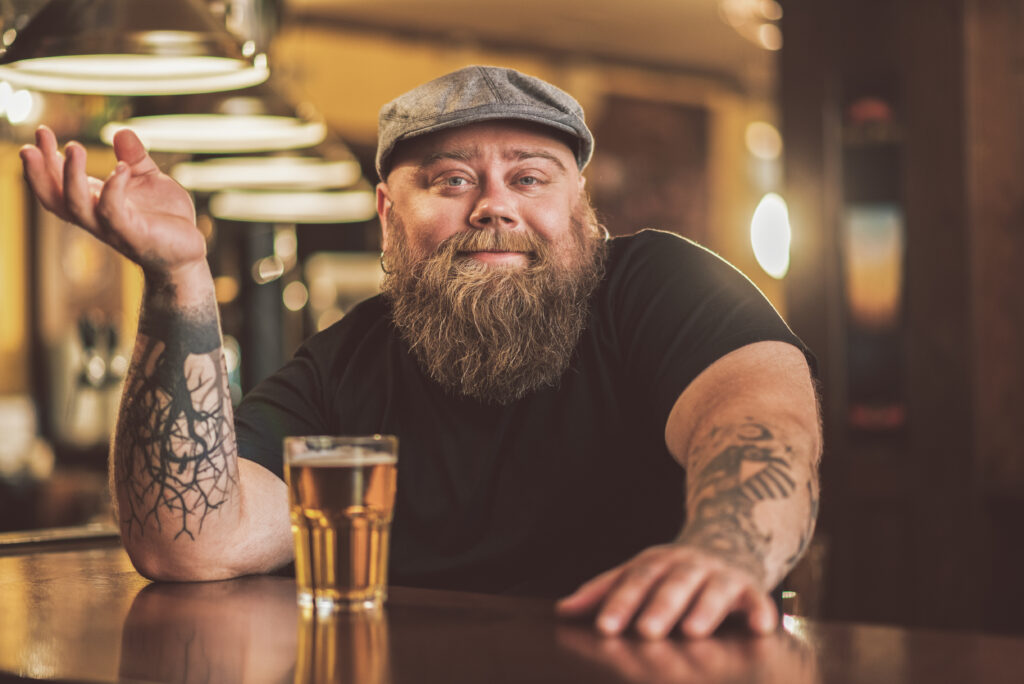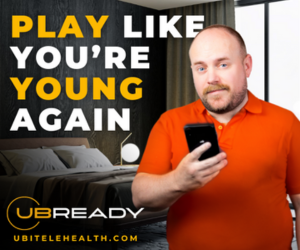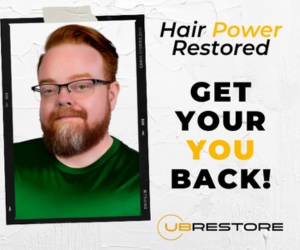Bear Tracks: Bear Masculinity
From the start gay bears have embraced and manifested a paradoxical masculinity. We have both embraced and celebrated a “natural” masculinity while also embracing and celebrating our “feminine” side–being gentle, nurturing, warm, and cuddly. We both challenge and reinforce hegemonic (traditional) masculinity at the same time. Some bears are working-class, sometimes cited as an explanation of our “natural” masculinity. Others are middle or upper class, “performing” their masculinity by imitating working-class bears.
Gay men have continued to be judged as “not real men” because we are not attracted to women, the cornerstone of being a “real man.” We used to be stereotyped as “wanting to be women” — we wear dresses, put on make-up, screech, take an interest in the arts, high culture, we eat quiche, and (horrors of horrors) love show tunes. Leathermen have traditionally faced double rejection by heterosexist society, for being both “hypermasculine” (in appearance) and “feminine” (in sexual orientation). Enter bears. Our manifestation of both a nurturing nature and possessing “natural” masculine qualities problematizes “homomasculinity.” Current gender theorists have adopted the term “hybrid masculinities.” Their studies have focused primarily on young, white, middle class, heterosexual men and their adoption of BIPEC men’s masculinities and/or “metrosexuality.” I find the term applicable to bear masculinity as well.

In Gay New York: Gender, Urban Culture, and the Making of the Gay Male World, 1890-1940 (1994), George Chauncey reports making two remarkable discoveries. Gay men were highly visible, and not particularly persecuted, in the era of the “pansy craze” (the late 1920s and 1930s) in Harlem. And there was a subculture of masculine gay men called “wolves” (which precedes its current slang use describing slender, hairy members of the bear tribe). A little earlier that this, Walt Whitman, the” good gay poet” and an archetypal working-class gay bear, often rode with the horse-drawn omnibus drivers in Manhattan, engaging in conversations with them and basking in their masculinity, and frequented Pfaff’s, a bohemian tavern, where he frequently met masculine working-class men for sex.
The homonormative aspect of bear masculinity continues to draw fire from some critics who argue the politics of gay masculinity should be to “queer” masculinity, and not “embrace” it. In his 2014 thesis “Take Off Your Masc: The Hegemonic Gay Men’s Gender Performance on Grindr,” Duncan Shuckerow argues that this idealization “is toxic and perpetuates the idea that ‘an attraction to men is an attraction to masculinity.’ Some critics read all masculinity as “toxic,” seemingly oblivious to the positive qualities found even in traditional masculinity, such as devotion to work and providing for one’s family. Critics of “toxic masculinity” incorrectly imply that gender-related issues are caused by inherent male traits. (You may wonder how having a hairy chest creates gender issues.)
To understand “toxic masculinity” one need look no further than its most extreme embodiment in Donald Trump. He is aggressive, misogynistic, racist, constantly expresses anger and rage, champions traditional gender roles, is an unrelenting bully, encourages violence, and presents himself as an authoritarian leader. He is the embodiment of straight, white, wealthy male privilege, right down to being oblivious to his extreme entitlement. To be fair, I also acknowledge Roy Cohn, the closeted, self-hating homosexual, who mentored Trump in exactly this school of ruthless, self-serving manipulation and “toxic masculinity.”
A component of “queer toxic masculinity” is to call out elements of racism and misogyny. While it is true that some gay men are misogynistic, I would argue that that is different from straight men’s misogyny. (This is a topic ripe for exploration.) Racism also has a long history in the gay men’s community. I remember when gay bars in the Castro would require three pieces of photo identity. They never asked white patrons for this, but it successfully blocked entry to black men.

Straight white men have a long history of eroticizing racial “others.” Early Europeans settlers in North America had sex with Native Americans. Even Thomas Jefferson fathered children with a black slave he owned. The French Impressionist painter Paul Gauguin celebrated the erotic appeal of Tahitian women and with whom he had a busy sexual life. Bestiality is sometimes portrayed in science fiction films. Among gay men, historically white gay men who were attracted to black men were called “dinge queens” and those attracted to Asian men “rice queens” by other white gay men. Thankfully, these terms have been abandoned.
As bear identity is being embraced by an increasingly diverse range of queer people, it further complicates masculinity. What will future generations make of trans bears, lesbian bears, BIPOC bears (a term which applies only to Americans*), and bears in Asia, Africa, the Pacific Islands, the Middle East, and Latin America?
*The new progressive pride flag with its explicit symbols of BIPEC inclusion extend only to Americans, leaving out ethnic realities in other cultures.





















